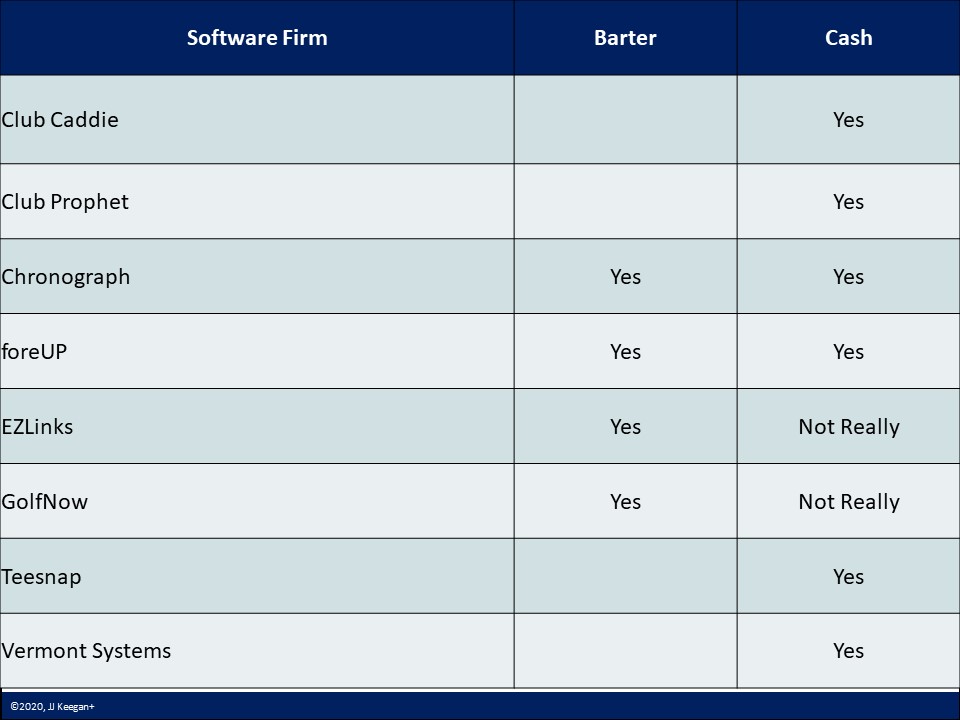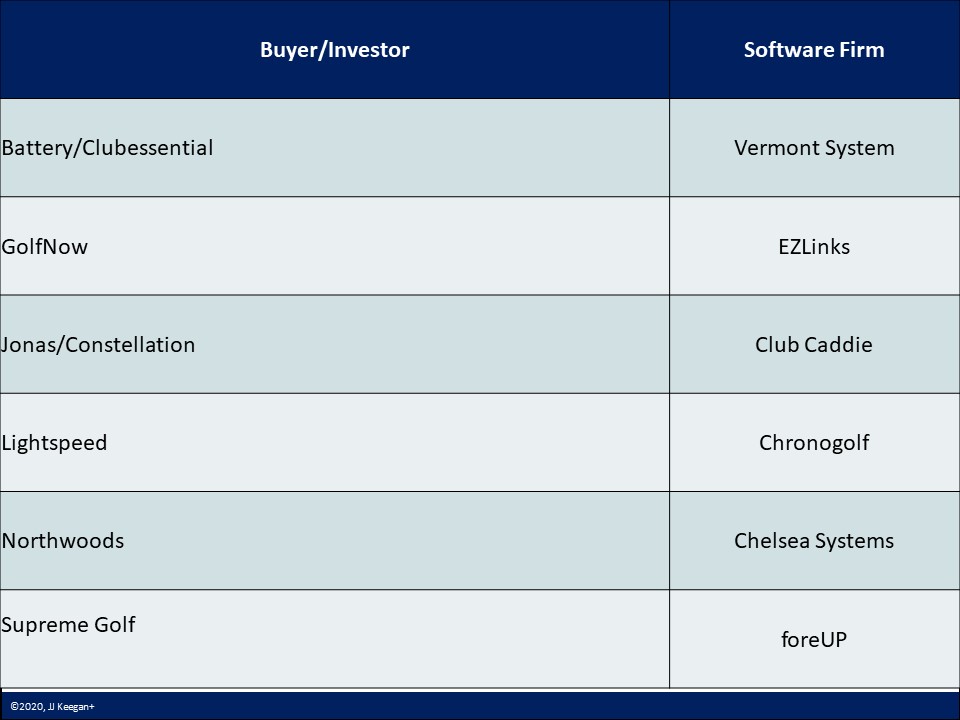
There are a plethora of software vendors that serve some aspect of the golf industry. If one Googles “golf management software,” 25 firms are listed (click here).
They can be divided loosely into two categories: they prefer to barter for payment, or they provide the golf course operator with a fixed cash payment. Spreading the wheat from the chaff, measured by installed customer base, the most frequent payment arrangements between a golf course and the leading software vendors are highlighted in the chart below:
But ratings based on four years ago is a lifetime in the golf software business. We believe the answer is the trouble lies with “the archer and not the bow.” In educating golf course owners, change never comes as fast as one would hope. The clear majority of golf course owners are stuck in an operational quagmire. They fail to think tactically or strategically and muddle along, underperforming with mediocre
results. Attempting to inform the masses is a fruitless task.
The reality is that the majority of positions, excluding senior management, require less than high school education. The responsibilities of those in the pro shop are the same as Nordstrom clerks or Starbuck’s baristas.
We believe the proper use of technology is a fundamental asset that can bolster the revenue of a golf course. Golf course owners can use marketing software tools, many of which are free, to increase their database, more effectively communicate with their customers, and better monitor the success of their efforts.
Requirements are Daunting — The Audience Is Challenging
It is with a great understanding and sincere sympathy that I emphasize the challenges that a technology software vendor faces in serving a golf facility. The hurdles include:
• No system, despite promises of some vendors to the contrary, is developed and supported solely with the firm’s internal resources. The computer’s operating system, database, credit card processing, and reliance on the Internet are some of the dependencies that a technology vendor must rely on for their solution to function. The integration of multiple platforms is necessary. Fingers are crossed that integration doesn’t break the core functionality of the golf management system when one component is upgraded.
• The informational needs of a municipal, military, daily fee, resort, and private club differ based on the type of customer and the policies of the golf course. That is the reason one firm dominates in the private club sector, Jonas/Constellation software, and another firm dominates in the public sector, GolfNow, a subsidiary of the Golf Channel, NBC, and Comcast. Neither of the sector leaders’ software would meet the needs in the other sector, as well.
• The variety, depth and breadth of modules (point of sale, tee time reservations, inventory, and merchandising with open-to-buy, food and
beverage, member billing, customer relationship management, event scheduling, lessons, website, marketing, accounting, payroll, etc.) are diverse, based on each facility having its preferred configuration of SKUs (stock-keeping units) and general ledger accounts. Unlike Word, Excel, and PowerPoint, a golf management system requires substantial configuration before utilizing it.
• The hardware devices from file servers, desktops, laptops, kiosks, iPads, and social applications displayed on an iPhone, each with their own operating systems, all create unique obstacles for consistency.
• The ability of a public golf course, whose gross revenue averages $1.4 million, to invest extensively in software systems is limited.
• Capable yield management software has never been developed for the golf industry because the development cost, likely to exceed $1 million, would not produce a positive return on investment unless the golf facility agreed in a revenue-sharing split, and that is unlikely.•
Software is current only on the date it is released. The financial strength of a software vendor to develop new releases taxes their internal resources and capital. When a large management company selected the G1 platform of GolfNow, the decision was predicated mainly on the financial strength of GolfNow to continue to aggressively release updates based on the evolving needs of their golf course clients.
• That was probably a flawed decision if the GolfNow research and development department has only 30 programmers, as understood by many within the industry. It took GolfNow effectively a decade, after acquiring a booking module from a hair salon, to release the G1 product in 2019, with credit card integration still pending.
• In contrast, Lightspeed has an entire team of developers envisioning and coding now what they believe will be the required applications five years hence.
The challenge of being a software developer in the golf industry is the rapid acceleration of change in technology and the constant custom development required. This is best manifested in the more successful software vendors acquiring other firms in the industry
to increase market share.
Since the fall of 2019, the following acquisitions have occurred:
After an investment exceeding $40 million, Teesnap is for sale by its owner, Allegiant Airlines, a public company (ALGT). Allegiant revealed in its January 2020 earnings call its intent to divest of Teesnap by the end of 2020. That could mean a sale, spinoff or closure, putting Teesnap customers at risk on several levels. Does a new owner charge more money? Will a closure follow an announcement, and will there be adequate time to find a replacement?
The point is, any decision on technology must include due diligence on the strength of the company and the likelihood of it staying in business over the long haul. Organic growth of golf course customers does not exist — new courses are not popping up on the landscape. Instead, companies like Teesnap and others must steal business from one another. Not all will succeed.
All that glitters is not gold. Being a software developer in the golf industry highlights the axiom, “Capitalism creates, capitalism destroys.”
Author: JJ Keegan, Envisioning Strategist and Reality Mentor. Click here
© 2020, JJKeegan+

